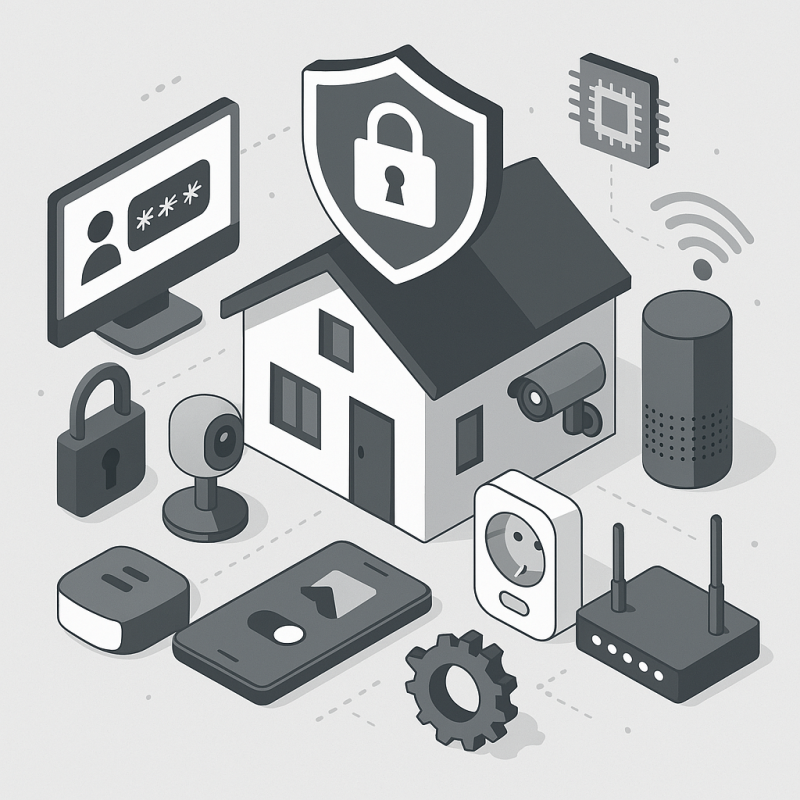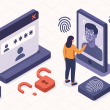Table of Contents Show
Smart home devices have taken center stage in how we interact with our living spaces. From controlling lights with your voice to checking who’s at the door from your phone, these connected gadgets are designed for ease and efficiency. But here’s the catch: the smarter your home becomes, the more vulnerable it is to digital threats.
In this guide, we’ll dig into the hidden risks of smart home tech, how to lock things down properly, and what you can do to protect your privacy and peace of mind. Whether you’re just getting started with your first smart speaker or you’ve got a fully connected house, the principles here will help you build a more secure digital home.
Understand the Risks
Before diving into what to do, let’s talk about why you need to do it.
1. Unauthorized Access
Hackers love poorly secured smart devices. If you’re using a default password or your Wi-Fi network is unsecured, it’s surprisingly easy for someone to break in digitally. Once inside, an attacker can spy through your security cameras, unlock your doors, or even access files on your computer if everything’s connected.
There have been cases where strangers have spoken to children through hacked baby monitors or blared music through smart speakers in the middle of the night. These aren’t just creepy pranks – they’re security breaches.
2. Data Privacy and Surveillance
Smart thermostats know when you’re home. Smart speakers listen for commands. Smart TVs track what you watch. All that data – when aggregated – builds a picture of your habits, preferences, and lifestyle. This data is often stored in the cloud and may be vulnerable to leaks, breaches, or even legal subpoenas.
3. Botnets and Large-Scale Attacks
Perhaps the most underappreciated risk is your device being drafted into a botnet. This is a network of infected devices that hackers use to launch Distributed Denial of Service (DDoS) attacks on websites and infrastructure. You might not even know your smart plug is participating in a cyberattack, but it could be.
The famous 2016 Mirai botnet attack that took down parts of the internet in the U.S. was largely powered by compromised smart home devices.
4. Physical Security
If a hacker gains control over your smart locks or garage door opener, they can literally walk into your home. What’s worse is that many users assume these systems are “set and forget,” leaving them vulnerable over time.
Best Practices for Securing Smart Home Devices
Now let’s talk solutions. Here are the most effective ways to harden your smart home setup.
1. Change Default Passwords – Immediately
This is non-negotiable. One of the easiest ways hackers gain access to devices is by using default login credentials. Sites like Shodan.io index insecure devices on the internet, and you’d be shocked how many are still using “admin/admin” or “123456” as credentials.
Instead, use a strong, unique password for every device. Ideally, your passwords should:
- Be at least 12 characters long
- Contain a mix of uppercase, lowercase, numbers, and symbols
- Avoid common words or patterns
Consider using a password manager like Bitwarden or 1Password to keep track of everything.
2. Keep Firmware and Apps Updated
Firmware updates often include critical security patches. But many devices don’t update automatically – or they do so infrequently. Get in the habit of checking for updates regularly through the manufacturer’s app or website.
Also update the companion mobile apps, which often serve as the control point for your devices. An outdated app can be a weak link in your chain.
Some routers even let you schedule firmware checks and push updates automatically – use this feature if it’s available.
3. Secure Your Wi-Fi Network Like a Fortress
Your Wi-Fi is the front door to your smart home. If someone gains access to it, they’re inside the perimeter.
Here’s what to do:
- Use WPA3 encryption (or WPA2 if WPA3 isn’t available)
- Change your default router name (SSID) to something that doesn’t reveal your identity or ISP
- Set a long, complex password for your Wi-Fi network
- Disable WPS (Wi-Fi Protected Setup), which is a known vulnerability
- Set up guest Wi-Fi for visitors to keep them off your main network
Some modern routers offer “smart home” segmentation features right out of the box. Use them.
4. Enable Two-Factor Authentication (2FA)
Many smart device ecosystems now offer 2FA for added protection. If someone steals or guesses your password, they still need a second form of verification – usually a code sent to your phone.
Amazon, Google Nest, Ring, and Apple HomeKit all support 2FA. Enable it wherever it’s available.
If your device doesn’t support 2FA, consider emailing the manufacturer to request it. Consumer pressure works.
5. Create a Separate Network for Smart Devices
Also known as “network segmentation,” this involves isolating smart devices from your computers, phones, and other sensitive data. Many modern routers let you create multiple VLANs or SSIDs to accomplish this.
This way, even if a smart bulb gets hacked, the attacker can’t pivot to your personal laptop or work documents.
Example setup:
| Device Type | Network Name | Access Rights |
|---|---|---|
| Phones & Laptops | HomeNetwork_Main | Full access |
| Smart Devices | HomeNetwork_IoT | Internet only, no LAN |
| Guest Devices | HomeNetwork_Guest | Limited internet access |
6. Disable Unused Features
If your device has a built-in microphone, cloud backup, or remote access – but you don’t use it – disable it. The fewer features a hacker can exploit, the better.
Here are some commonly overlooked features to disable:
- UPnP (Universal Plug and Play) on routers
- Remote administration on devices
- Voice purchasing or voice-controlled payments
Each additional feature is an opportunity for a vulnerability.
7. Monitor Device Activity
Keep an eye on your network traffic using your router’s dashboard or apps like Fing, Firewalla, or Pi-hole. These tools can help you:
- Spot unusual data spikes
- Identify unknown devices
- Block suspicious IPs
You don’t need to be a network engineer. Most tools have friendly interfaces that make monitoring easy.
You should also audit device logs (if available) to check login attempts or geolocation anomalies.
8. Be Cautious with Third-Party Integrations
Many devices offer integrations with third-party services to enhance functionality – like using IFTTT or linking with a voice assistant. But these integrations often require permissions and data access.
Before enabling an integration, ask yourself:
- Do I really need this?
- Who owns the third-party service?
- What data are they collecting?
Stick to integrations from trusted, reputable developers. Read the privacy policy if you’re unsure.
Advanced Security Steps
If you’re more tech-savvy – or just cautious – here are some extra precautions to level up your smart home security.
Use a Firewall or Dedicated Security Appliance
You can set up a firewall using open-source solutions like pfSense or use off-the-shelf products like Firewalla Blue or Bitdefender Box. These tools give you fine-grained control over your network traffic.
They can also:
- Detect anomalies
- Block malicious connections
- Monitor device behavior over time
Implement MAC Address Filtering
Every device has a unique MAC (Media Access Control) address. Your router can restrict access based on approved MAC addresses – kind of like a whitelist.
Keep in mind this isn’t foolproof (MACs can be spoofed), but it adds one more hurdle for an attacker.
Use DNS Filtering
Configure your router to use secure DNS providers like:
- Cloudflare (1.1.1.1)
- Google (8.8.8.8)
- OpenDNS (208.67.222.222)
These services offer content filtering and block known malicious domains.
Tools like Pi-hole can also block advertising and tracking domains from all devices on your network.
Protecting Your Privacy
Now let’s look at your data. Securing the devices is step one, but protecting your privacy is equally important.
1. Review and Adjust Privacy Settings
Every smart device has a menu buried somewhere that lets you control what it collects. Visit the settings page and:
- Opt out of data sharing or advertising
- Delete stored voice recordings
- Disable location tracking
- Turn off “cloud history” or usage logs
Even reputable companies collect more than you think. Don’t assume privacy by default – configure it.
2. Limit Voice Recordings and Camera Access
Voice assistants like Alexa, Siri, and Google Assistant store audio snippets to improve their AI. But these recordings can be accessed by employees or even leaked.
To reduce this risk:
- Turn off “always listening” if you don’t need it
- Mute smart speakers when not in use
- Regularly delete stored voice logs (Amazon and Google both allow this)
When it comes to cameras:
- Turn off cameras when not needed
- Use physical lens covers for extra assurance
- Avoid placing them in bedrooms, bathrooms, or children’s rooms
3. Be Mindful of Camera and Sensor Placement
Remember: cameras, microphones, and motion sensors collect data about your life. Be intentional about where you place them.
Here are some placement tips:
| Device | Suggested Placement | Avoid Areas |
|---|---|---|
| Smart Camera | Entryways, living rooms | Bedrooms, bathrooms |
| Motion Sensor | Hallways, doors | Private spaces |
| Voice Assistant | Kitchen, living room | Near sensitive conversations |
Also, ensure outdoor cameras don’t capture your neighbor’s property. That can raise legal concerns depending on where you live.
Educate Your Household
Security isn’t just your job. Everyone in your household plays a role.
- Teach kids not to share passwords or device info
- Set rules about connecting new devices to the network
- Create a “digital hygiene” checklist everyone follows
And if you have guests frequently using your home Wi-Fi, consider locking down your main network and giving them limited access via a guest network.
What to Do If You Suspect a Breach
If you think one of your devices has been compromised:
- Disconnect it from the network immediately
- Change your Wi-Fi password and any related device passwords
- Factory reset the device
- Check for any unusual activity in associated accounts (like Amazon or Google)
- Report the incident to the manufacturer
Monitor your bank accounts and emails for suspicious activity in the weeks following the breach. Many smart home platforms are linked to payment methods or personal accounts.
The Future of Smart Home Security
The landscape is evolving. More companies are rolling out:
- End-to-end encryption
- Local-only data storage options
- Built-in privacy controls and hardware kill switches
Apple, for example, uses HomeKit Secure Video, which processes video locally and encrypts it before storing it in iCloud.
Amazon and Google now offer auto-deletion of stored recordings, though users have to enable it manually.
The future may even involve blockchain-based device authentication and decentralized security protocols – though we’re not quite there yet.
Final Thoughts
Smart homes are awesome. They save time, reduce energy bills, make life easier, and add an undeniable cool factor. But without proper security, you’re essentially leaving the front door open and hoping no one walks in.
Here’s a quick checklist to recap:
| Step | Description |
|---|---|
| Change default passwords | Use strong, unique passwords for every device |
| Update firmware and apps | Regularly install the latest security patches |
| Secure your Wi-Fi | Use WPA3, disable WPS, and set a strong password |
| Enable two-factor authentication | Add an extra layer of account protection |
| Segment your network | Keep smart devices separate from critical systems |
| Monitor activity | Watch for unusual behavior or unknown devices |
| Protect your privacy | Manage settings, limit recordings, use mute buttons |
| Educate your household | Make security a shared responsibility |
With vigilance and a few strategic changes, your smart home can be both smart and secure.
Additional Resources
- Mozilla’s Privacy Not Included Guide – See which devices respect your privacy
- National Cyber Security Centre (UK) – Official guidance for securing smart home devices








